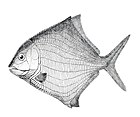| Styracopterus Temporal range:
| |
|---|---|
| Scientific classification | |
| Kingdom: | |
| Phylum: | |
| Class: | |
| Order: | |
| Family: | Moy-Thomas, 1937
|
| Genus: | †Styracopterus Traquair, 1890
|
| Binomial name | |
| †Styracopterus fulcratus Traquair, 1890
| |
| Synonyms | |
Styracopterus is an extinct genus of prehistoric bony fish that lived during the Tournaisian stage of the Mississippian epoch of Scotland and Eastern European Platform, Russia.[1][4]
See also
[edit]References
[edit]- ^ a b Sepkoski, Jack (2002). "A compendium of fossil marine animal genera". Bulletins of American Paleontology. 364: 560. Retrieved 2009-04-24.
- ^ "Palaeonisciformes". Paleobiology Database. Retrieved 19 Nov 2012.
- ^ a b Gardiner, Brian G. (1985). "Actinopterygian fish from the Dinantian of Foulden, Berwickshire, Scotland". Transactions of the Royal Society of Edinburgh: Earth Sciences. 76: 61–67. doi:10.1017/S0263593300010312. S2CID 129150300.
- ^ Schultze, Hans-Peter; Mickle, Kathryn E.; Poplin, Cecile; Hilton, Eric J.; Grande, Lance (2021). Handbook of Paleoichthyology, 8A. Actinopterygii I. Palaeoniscimorpha, Stem Neopterygii, Chondrostei. Dr. Friedrich Pfeil, München. p. 299. ISBN 978-3-89937-272-4.








Well, that’s interesting to know that Psilotum nudum are known as whisk ferns. Psilotum nudum is the commoner species of the two. While the P. flaccidum is a rare species and is found in the tropical islands. Both the species are usually epiphytic in habit and grow upon tree ferns. These species may also be terrestrial and grow in humus or in the crevices of the rocks.
View the detailed Guide of Psilotum nudum: Detailed Study Of Psilotum Nudum (Whisk Fern), Classification, Anatomy, Reproduction